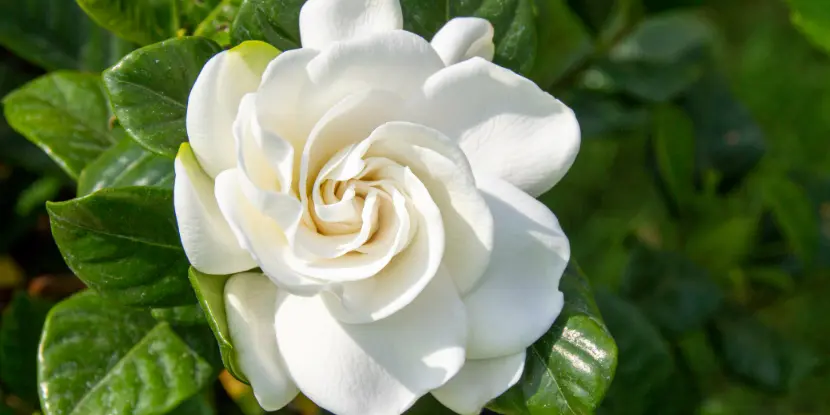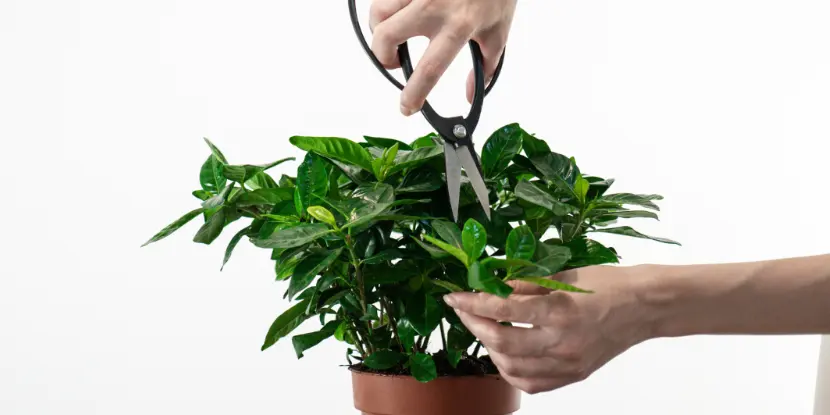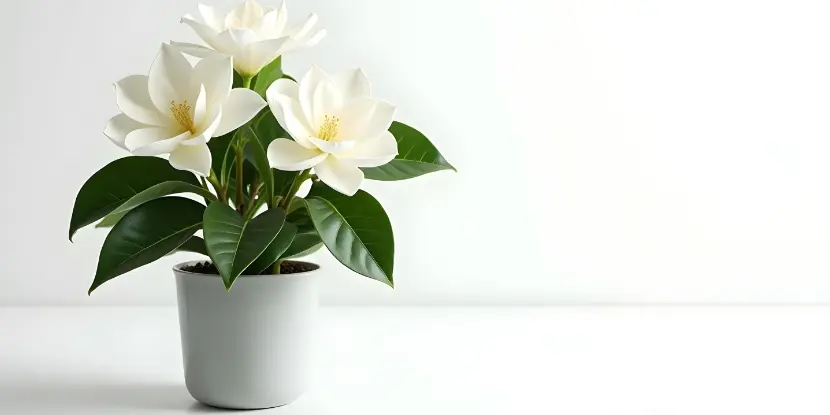The gardenia comes from tropical and subtropical regions of Africa, Asia, and the Pacific Islands.
The plant adapts well to Southern California’s benign climate and rewards the attentive gardener with fragrant, creamy white blossoms from late spring through early summer.
In favorable conditions, blooming can extend into early fall. Gardenias do equally well as landscape and potted plants.
Propagating Gardenias
- Gardenias are typically propagated from cuttings.
- Take 4- to 6-inch cuttings with at least two or three sets of leaves.
- Remove the bottom set of leaves and dip the cutting’s end in rooting hormone.
- Insert it into a well-draining potting mix. Keep the soil consistently moist until roots form.

Closeup of a gardenia blossom.
Light & Temperature
- Gardenias thrive in bright, indirect sunlight.
- In Southern California, they need afternoon shade to prevent leaf scorch.
- Ideal daytime temperatures for gardenias are between 65°F and 75°F.
- Slightly cooler temperatures are beneficial at night.
- Gardenias are sensitive to temperature fluctuations, so consistent warmth is crucial for healthy growth.
Soil Preparation
- Gardenias prefer well-draining, acidic soil.
- Amend the planting area with organic matter like peat moss or compost to enhance drainage and acidity.
- The ideal soil pH for gardenias is between 5 and 6.5.
- Use a soil pH test kit periodically to ensure the soil maintains the proper acidity balance.
Planting Gardenias
- Prepare the planting hole twice as wide and deep as the gardenia’s root ball.
- Space plants at least 3 feet apart to allow for proper air circulation and prevent overcrowding.
- Carefully remove the plant from its container, gently loosen any encircling roots, and place it in the hole at ground level.
- Backfill with a mixture of native soil and organic matter.
- Water thoroughly to help settle the soil around the roots.
- Mulch with 2–3 inches of organic material to help retain moisture and regulate soil temperature.

Gardenia blossoms have a sweet fragrance.
Watering
- Keep soil moist but not saturated.
- Allow the top inch of soil to dry out before watering again.
- Avoid watering the leaves, which can lead to leaf spot and other diseases.
Fertilizing
- Use a fertilizer formulated for acid-loving plants, like a rhododendron or azalea food.
- Apply fertilizer in the early spring before new growth appears and again in late summer to promote fall blooming.
- Follow package instructions. Overfertilizing can damage gardenia plants.
Pruning
- Gardenias benefit from regular pruning to maintain their shape and promote healthy growth.
- Prune after flowering has ended, as the plant sets buds for next year’s blooms on old wood.
- Always use clean, sharp pruning tools and disinfect them between cuts with rubbing alcohol to prevent the spread of diseases.

A gardener prunes a gardenia plant.
Pests & Diseases
- Gardenias are susceptible to aphids, mealybugs, and scale insects.
- Regularly inspect the plant for signs of infestation and treat it with insecticidal soap or neem oil if necessary.
- Leaf spot, root rot, and powdery mildew are common diseases affecting gardenias.
- Proper watering techniques and good air circulation can help prevent disease.
- If necessary, treat with a fungicide according to package instructions.
Growing Gardenias in Pots
- Gardenias make excellent container plants in Southern California.
- Use a pot with good drainage and fill it with a well-draining, acidic potting mix.
- Fertilize regularly with an acid-loving plant food.
- Repot the plant every 2–3 years to refresh the soil and prevent root-bound growth.

Gardenias are excellent container plants. You can grow them indoors or outdoors.
FAQs: Caring for Gardenias
Q: Can gardenias grow indoors in Southern California?
Yes, if they receive bright, indirect light and consistent humidity levels. Place them near a sunny window and mist the leaves regularly, or use a humidity tray to maintain moisture.
Q: How do I increase humidity for my gardenias?
Use a humidity tray filled with water and pebbles, mist the leaves regularly, or place a small humidifier nearby.
Q: What should I do if my gardenia’s leaves turn yellow?
Yellowing leaves can indicate iron deficiency or improper watering. Check the soil pH, amend with iron chelates if needed, and adjust your watering routine to maintain consistent moisture levels.
Q: How often should I prune my gardenias?
Prune your gardenias annually right after they finish blooming. This timing ensures you won’t accidentally cut off any buds set for next year’s flowers. Regular pruning helps maintain shape and encourages bushier growth.
Q: Can gardenias tolerate full sun in Southern California?
While gardenias thrive in bright, indirect sunlight, they should be shielded from the harsh afternoon sun to prevent leaf scorch. Provide them with some shade during the hottest parts of the day.
Q: What is the ideal spacing between gardenia plants?
Gardenias should be planted at least 3 feet apart to ensure adequate air circulation. Proper spacing reduces humidity around the foliage, reducing the risk of diseases like root rot and powdery mildew.
Q: Why are my gardenia buds falling off before blooming?
Bud drop in gardenias can be caused by inconsistent watering, inadequate light, or sudden temperature changes. Ensure the plant receives uniform moisture and adequate light and is exposed to stable temperatures.
Q: How can I protect my gardenias from frost in Southern California?
To insulate them against the cold during frost warnings, cover them with frost cloth or burlap. Mulch placed around the base can also provide an extra layer of protection.
Q: What are the signs of overwatering gardenias?
Signs of overwatering include yellowing leaves, wilting, and root rot. To prevent this, ensure proper drainage and allow the top inch of soil to dry out before watering again. Adjust your watering schedule based on weather conditions and avoid letting the plant sit in waterlogged soil.

